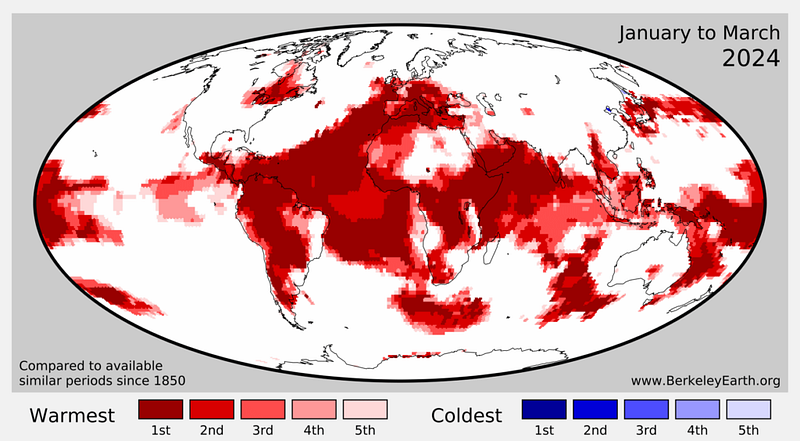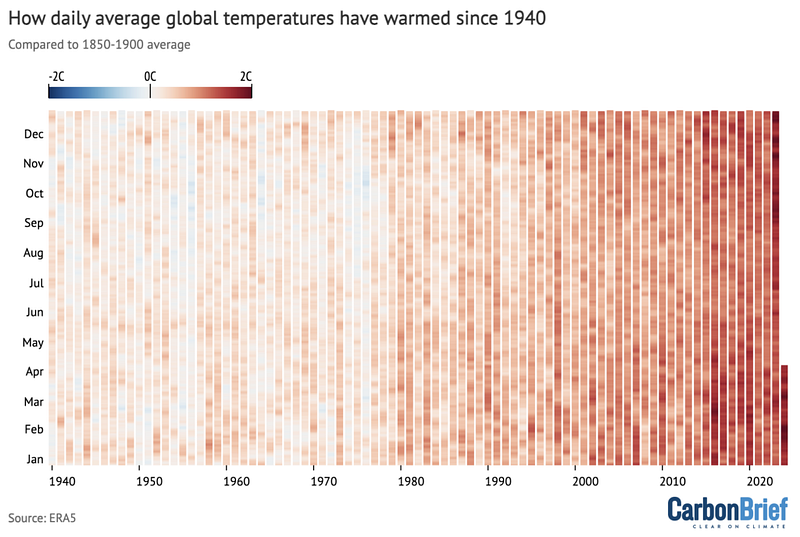Can 2024 Surpass 2023 in Heat? A Glimmer of Hope Amidst Chaos
Written on
The Unprecedented Climate Shift
It’s May 1, 2024, and the weather in my hometown of Patagonia has already experienced significant snowstorms—a stark contrast to previous years when such weather wouldn’t arrive until late May or even June.
The pattern has shifted dramatically: the transition from summer to winter is abrupt, with warm, sunny days quickly turning into chilly, snowy conditions. The vibrant colors of autumn are fading as trees transition abruptly from green to white. As we gather wild mushrooms after enjoying a snowy day, it’s evident that this sudden change feels unsettling; I’m not quite ready for winter yet.
In the broader context, this local phenomenon reflects a global crisis: climate extremes are becoming the norm, with severe droughts and floods, scorching heatwaves, frigid temperatures, rampant wildfires, and melting glaciers occurring worldwide without warning. Following 2023, the hottest year on record, 2024 is on track to either match or exceed these extreme temperatures.

The Escalating Temperature Trend
April 2024 marked another month of record-breaking temperatures, contributing to a series of 11 consecutive months of highs. Historically, peak temperatures have followed El Niño events, as seen during the significant years of 1998 and 2016, which recorded extraordinary temperature spikes.
However, 2023 defied expectations, exhibiting extreme warmth during a time usually marked by gradual increases. This anomaly resulted in temperatures far exceeding scientific projections, with remarkable records of 0.5°C in September and 0.4°C in October remaining largely unexplained.
Despite a slight easing, global temperatures are still alarmingly elevated—approximately 1.6°C above pre-industrial levels, following the peak of the 2024 El Niño event.

The first quarter of 2023 witnessed unprecedented warm temperatures across various regions:
- In the Netherlands, March saw only the second frost-free month recorded.
- The Baltic region also experienced unusually high temperatures.
- Great Lakes in Eastern North America encountered record-low ice cover.
- Central America faced severe drought, impacting the Panama Canal.
In Patagonia, February brought extreme heatwaves, and March was characterized by temperature extremes—cold in the south and scorching in the north, with anomalies reaching up to +5.7°C. Following this, snow arrived unexpectedly.
The state of Antarctic sea ice has been troubling, with near-record lows for six months post-September 2023. Meanwhile, Arctic ice levels have also been concerning, consistently hitting record lows early in 2024.

Is 2024 Returning to Predictability?
While predicting the future is inherently uncertain, early signs suggest that 2024 might contend for record-breaking warmth. It’s important to note that the initial quarter is not necessarily reflective of the entire year.
The upcoming months are crucial: will we revert to a typical cooling trend as El Niño fades, or will temperatures remain alarmingly high as they did in late 2023? By year-end, temperatures are expected to hover around 1.5°C, in line with 2023 and just above the critical limit set by the Paris Agreement.
However, these projections depend on a return to established climate patterns, which were significantly disrupted in 2023. Gavin Schmidt, director of NASA’s Goddard Institute for Space Studies, expressed concern that 2023 has posed unprecedented challenges to climate predictions. If anomalies persist beyond August, it may indicate a fundamental shift in our climate system.
A Ray of Hope in Unity
Discussing climate change often feels like sharing an endless stream of bad news. I sometimes feel like a harbinger of doom, and I know it can be overwhelming.
Yet, I refuse to succumb to this narrative. I believe in our collective potential to inspire change and raise awareness, and I have faith in each of you to join me in transforming individual efforts into a powerful movement toward a brighter future.
We must cultivate positive momentum. The coming years will undoubtedly be difficult as we confront political strife, environmental disasters, economic challenges, and societal unrest. The wealth gap continues to widen, while competition for dwindling resources intensifies.
A recent Nature study estimated that by 2050, climate change could inflict economic damages amounting to $38 trillion annually, translating to a global income reduction of 19%. This isn’t to instill despair but to prepare you for the challenges ahead.
However, there is hope. La Niña may offer some relief and disrupt the current trend of record-breaking temperatures. For instance, the North Atlantic Ocean has recently cooled after an unprecedented stretch of high temperatures.
Additionally, China is shifting away from fossil fuels, focusing on green initiatives. California has exceeded its power needs through renewable sources almost daily this spring, while the world’s largest battery recycling facility claims to recover nearly 95% of battery minerals profitably, alleviating some pressure from the mining sector.
We must amplify our efforts. Together, we can create a significant, lasting impact. It’s about building momentum, one action at a time.
Be vocal.
Thank you for your attention and support! Join the 500+ members of the Antarctic Sapiens community for weekly updates and insights.
Chapter 2: Analyzing Climate Records
Will 2024 be the Hottest Year Ever Recorded? - This video delves into the rising global temperatures, exploring the implications and what lies ahead.
Chapter 3: The Reality of 2023 and 2024
2023 was the Hottest Year on Record, but 2024 is on Track to be Even Hotter - This video discusses the alarming trend of increasing temperatures and its potential consequences.